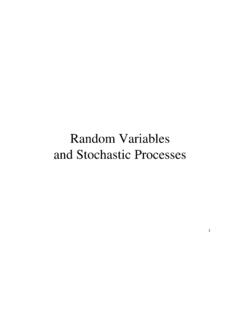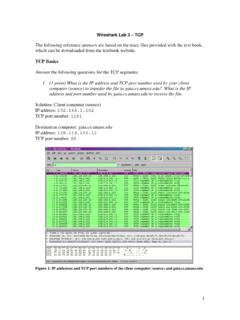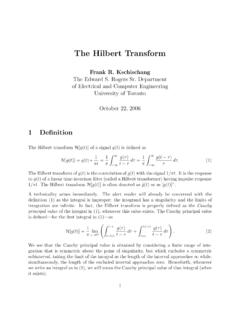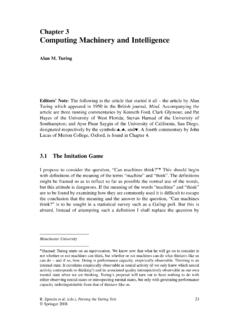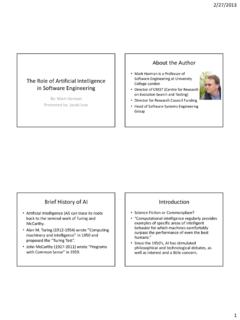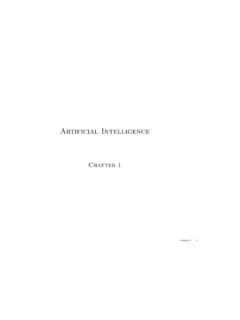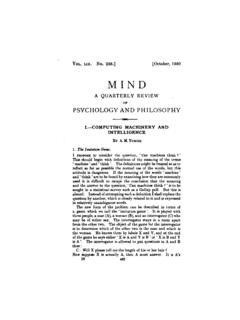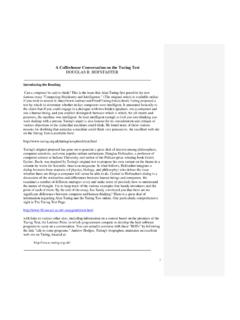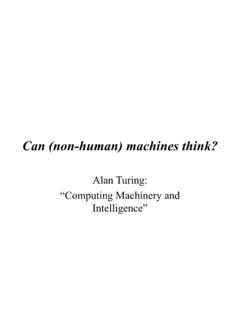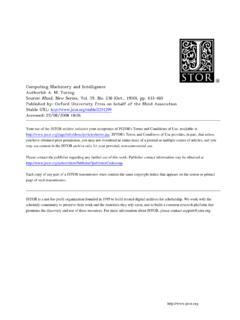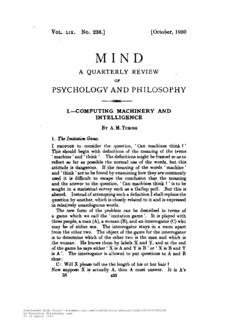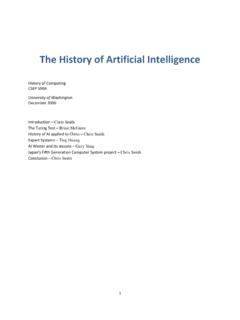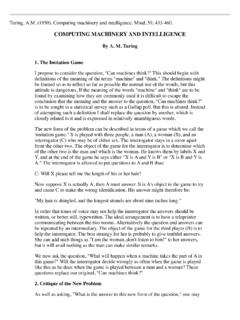Transcription of CS494/594: Artificial Intelligence - UTK
1 cs494 /594: Artificial Intelligence Fall 2013 Tuesday/Thursday, 11:10 AM 12:25 PM Instructor: Dr. Lynne E. Parker TA: Hao Zhang Artificial Intelligence is the study of how to make real computers act like the ones in the movies. --Anonymous Outline Overview syllabus and class policies Course Overview Introduction to AI (Chapter 1) What is AI? A brief history The state of the art Intelligent Agents (Chapter 2) Agents and environments Rationality PEAS (Performance measure, Environment, Actuators, Sensors) Environment types Agent types (next time) Overview of Syllabus and Class Policies (See handout) Course Overview Introduction to AI and Intelligent Agents Problem-solving Heuristic Search Constraint Satisfaction Searching with non-deterministic actions and partial observability Online search Advesarial search (games)
2 Constraint propagation Knowledge, reasoning, and planning First order logic Classical planning Planning/acting in real world Knowledge representation Dealing with uncertainty probabilistic reasoning Natural language processing (if time allows) Perception and robotics Philosophical and ethical issues Practical applications What is AI? Systems that think like humans The automation of activities that we associate with human thinking activities such as decision-making, problem solving, learning, .. (Bellman, 1978) Systems that think rationally The study of mental faculties through the use of computational models.
3 (Charniak and McDermott, 1985) Systems that act like humans The art of creating machines that perform functions that require Intelligence when performed by people , (Kurzweil, 1990) Systems that act rationally concerned with intelligent behavior in artifacts. (Nilsson, 1998) Acting humanly: The Turing Test Turing (1950) computing machinery and Intelligence : Can machines think? Can machines behave intelligently? Operational test for intelligent behavior: the Imitation Game Predicted that by 2000, a machine might have a 30% chance of fooling a lay person for 5 minutes Anticipated all major arguments against AI in following 50 years Suggested 6 major components of AI: knowledge representation, automated reasoning, natural language understanding, machine learning, computer vision, robotics Problem: Turing test is not reproducible, constructive, or amenable to mathematical analysis HUMAN INTERROGATOR HUMAN AI System ?
4 Thinking humanly: Cognitive modeling approach 1960s cognitive revolution : information-processing psychology replaced prevailing orthodoxy of behaviorism Requires scientific theories of internal activities of the brain What level of abstraction? Knowledge or circuits? How to validate? Requires: 1)Predicting and testing behavior of human subjects (top-down) 2)or, Direct identification from neurological data (bottom-up) Both approaches (roughly, Cognitive Science and Cognitive Neuroscience) are now distinct from AI Both share with AI the following characteristic: The available theories do not explain (or engender) anything resembling human-level general Intelligence Hence, all three fields share one principal direction!
5 Thinking rationally: Laws of Thought approach Normative (or prescriptive) rather than descriptive Aristotle: what are correct arguments/thought processes? Several Greek schools developed various forms of logic: Notation and rules of derivation for thoughts; may or may not have proceeded to the idea of mechanization Direct line through mathematics and philosophy to modern AI Problems: 1)Not all intelligent behavior is mediated by logical deliberation 2)What is the purpose of thinking? What thoughts should I have? Acting Rationally: Rational Agent approach Rational behavior: doing the right thing The right thing: that which is expected to maximize goal achievement, given the available information Doesn t necessarily involve thinking , blinking reflex but thinking should be in the service of rational action Aristotle (Nicomachean Ethics).
6 Every art and every inquiry, and similarly every action and pursuit, is thought to aim at some good Rational agents An agent is an entity that perceives and acts This course is about designing rational agents Abstractly, an agent is a function from percept histories to actions: For any given class of environments and tasks, we seek the agent (or class of agents) with the best performance Caveat: computational limitations make perfect rationality unachievable design best program for given machine resources *:fPA Foundations of AI Philosophy (428 BC Present) Can formal rules be used to draw valid conclusions?
7 How does the mental mind arise from a physical brain? Where does knowledge come from? How does knowledge lead to action? Aristotle, Leonardo da Vinci, Pascal, Descartes, etc. Foundations of AI (con t.) Mathematics (~800 present) What are the formal rules to draw valid conclusions? What can be computed? How do we reason with uncertain information? Logic, computation (algorithms), probability Foundations of AI (con t.) Economics (1776-present) How should we make decisions so as to maximize profit? How should we do this when others may not go along? How should we do this when the payoff may be far in the future?
8 Utility, decision theory, game theory, operations research, Markov decision processes Foundations of AI (con t.) Neuroscience (1861-present) How do brains process information? Moore s law predicts that CPU s gate count will equal brain s neuron count around 2020. But, even though a computer is a million times faster in raw switching speed, the brain is actually 100,000 times faster at what it does. Foundations of AI (con t.) Psychology (1879 present) How do humans and animals think and act? Behaviorism, cognitive psychology, cognitive science Foundations of AI (con t.) Computer engineering (1940 present) How can we build an efficient computer?
9 AI requires: (1) Intelligence , (2) an artifact ( , a computer upon which the Intelligence is generated) Foundations of AI (con t.) Control theory: Maximizing an objective function over time Uses calculus and matrix algebra, which lend themselves to systems that are describable by fixed sets of continuous variables; Exact analysis typically feasible only for linear systems AI: Designing systems that behave optimally Founded as a way to escape from limitations of the mathematics of control theory Use of logical inference and computation allows AI to consider problems such as language, vision, and planning, which are outside the field of control theory Control theory and Cybernetics (1948 present) How can artifacts operate under their own control?
10 Foundations of AI (con t.) Linguistics (1957-present) How does language relate to thought? Computational linguistics, natural language processing, knowledge representation Summary of AI Prehistory Philosophy -- logic, methods of reasoning -- mind as physical system -- foundations of learning, language, rationality Mathematics -- formal representation and proof -- algorithms, computation, (un)decidability, (in)tractability -- probability Economics -- formal theory of rational decisions Neuroscience -- plastic physical substrate for mental activity Psychology -- adaptation -- phenomena of perception and motor control -- experimental techniques (psychophysics, etc.)
